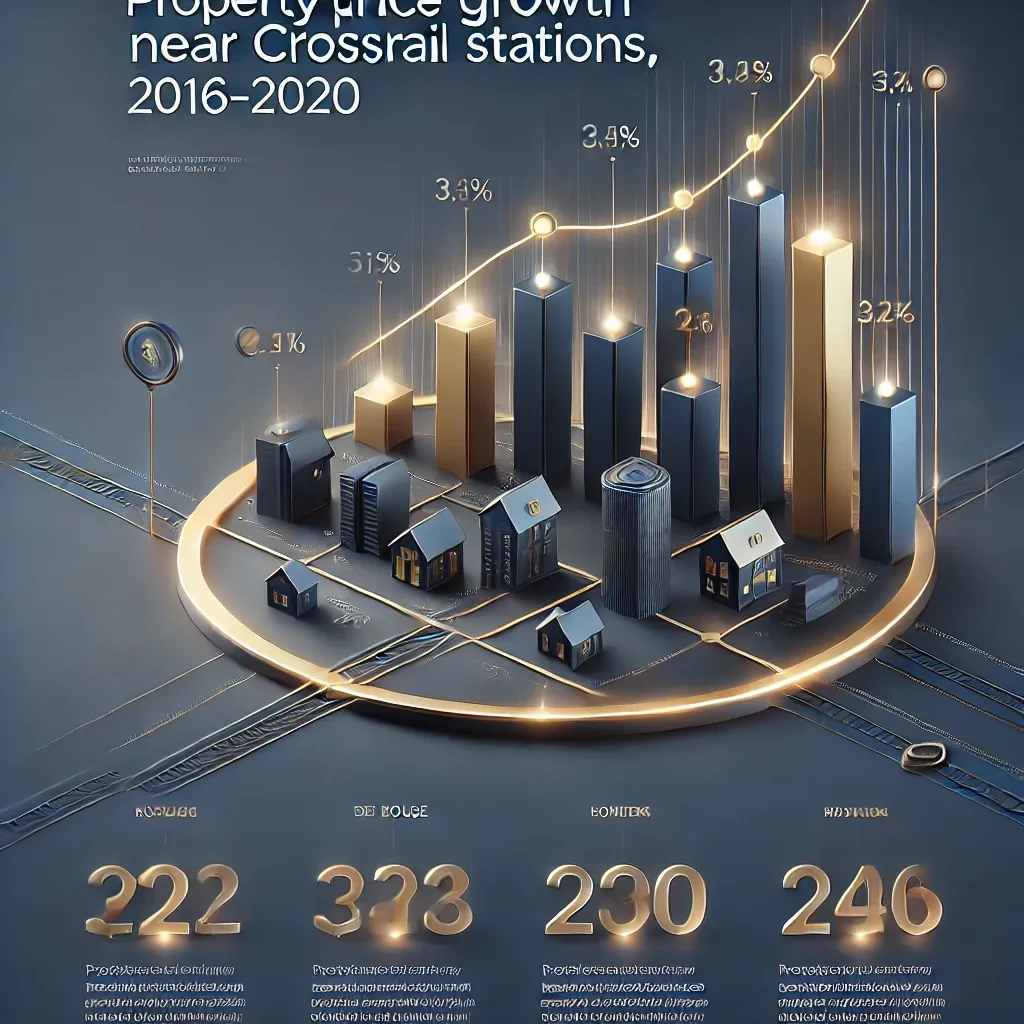How will the Crossrail project change the real estate market in London?

- How will the Crossrail project change the real estate market in London?
- How is the rise in housing prices related to the Crossrail project and its impact on the market?
The Crossrail project in London
In 2009, a significant project called Crossrail began in London, the capital of the United Kingdom. This high-speed railway line, approximately 118 kilometers long, will serve as a link between the central areas of the city and its peripheral parts in both the east and the west.
This innovative transportation system will significantly reduce travel time by an average of 15 minutes, allowing 1.5 million passengers to reach the heart of London in less than 45 minutes. Upon completion of construction in 2019, Crossrail will become one of the most ambitious infrastructure projects in the history of the British capital, not only improving transport flows but also contributing to the development of remote areas.
The impact on the areas around the new line
The transitions and remote areas that gained access to the trendy line will be significantly transformed, leading to an increase in interest in both the purchase and rental of residential real estate. Considering the impact of Crossrail on aspects such as:
- increase in housing prices,
- rental levels,
- changes in rental rates
- transport accessibility,
Experts have identified areas in London that are worth investing in. This will not only help increase the value of properties but also provide a stable rental income.
Price increase due to Crossrail
According to a study conducted by analysts, the impact of Crossrail on property prices in the vicinity of the newly created stations became evident immediately after the project's official confirmation. Information provided by Zoopla shows that from the start of construction in May 2009 until February 2016, prices for apartments and houses near the future high-speed railway stations increased on average by188 thousand poundsthat amounted to52%The growth rate – this indicator exceeded the overall increase in property prices in England, which amounted to30%.
Over the past seven years, since the start of construction, the price categories of real estate in the area of Crossrail stations have increased by38-66%The largest price increase was observed in places such as:
- “Bond Street”
- “Forest Gate”
- "West Ealing"
- “Hanwell”
- “Ecton”
- “Ealing Broadway”
- “Paddington”
- “Liverpool Street”
where the price increase was60-66%.
Price growth forecast
Many experts agree that in the coming years, the cost of housing near the new transport line will rise faster than the average across the capital. Estimates of price increases vary depending on the analysts' perspectives. For example, experts from JLL predict that the most noticeable price growth will occur in the Woolwich area by 2020.
According to them, from 2016 to 2020, property prices near Crossrail stations could increase by more than7%in relation to similar indicators for Greater London, and in certain cases, this figure will even reach16%.
Projected increase in value
It should also be noted that the report prepared by JLL in March 2016 indicated that over the next four years, housing prices near stations would increase in the range of8 to 39%The maximum growth is expected in the areas adjacent to:
- “Woolidge”
- “West Dracon”
- “Whitechapel”
This confirms the attractiveness of these locations for investment. The development of the Crossrail project will undoubtedly have a significant impact on the real estate market, fostering demand and shaping new trends.
The rise in housing prices from 2016 to 2020
From 2016 to 2020, there was an impressive increase in property prices in areas close to Crossrail stations, according to research conducted by JLL. By the end of 2015, housing price levels showed significant variation, ranging from £4,000 to £32,300 per square meter, depending on the location of the specific station.
For example, Bond Street stood out as the most expensive area, where the cost of housing reached £32,300, while in Burnham, housing was valued at only £4,000 per square meter.
Forecasts for the end of 2020
By the end of 2020, it was expected that average prices for residential real estate would range from £5,400 to £34,900 per square meter.
29 January
29 September
9 October 2024
9 October 2024
In less well-known areas, such as Harold Wood and Seven Kings, the price increase has been much more modest, amounting to just £0.3 thousand.
The importance of transportation accessibility for tenants
The Knight Frank study showed that80%tenants in London highlight transport accessibility as one of the main factors influencing their choice of housing. Moreover,91%The respondents prefer to be within a kilometer radius of the nearest metro station.
This information highlights the emerging trend of moving to the suburbs, which are becoming increasingly attractive against the backdrop of rising prices in the central areas of the city.
Preferences of the residents
- Many residents working in financial centers now prefer to buy or rent houses with gardens in the suburbs instead of compact apartments in the city center.
- This makes suburban areas more desirable for living.
Improvement of transportation links
Improving transport routes and connections in areas adjacent to Crossrail stations is an important factor contributing to the growth of tenants interested in these areas. JLL forecasts predict that rents in such areas could increase by22–36%during the specified period.
The largest increases are expected in areas such as Whitechapel, Woolwich, and Ealing Broadway, where growth could range from33%to36%.
The Crossrail project and its impact on construction
In addition to this, the completion of the Crossrail project is stimulating the creation of new residential complexes and commercial properties.2012by2021In the years to come, it is planned to build approximately within a kilometer of the Crossrail stations.57 thousandnew housing units and3.25 millionsquare meters of commercial real estate.
This will not only increase the availability of housing but also create new jobs and significantly improve the local infrastructure.
Conclusion
As a result, the synergy between improved transport accessibility, further increases in rental prices, and active construction of new properties makes areas near Crossrail stations particularly attractive for both tenants and investors.
Such changes contribute to the large-scale development of these areas, opening up new opportunities for their residents and tenants. Overall, it can be confidently stated that in the future, the real estate market around Crossrail stations will develop significantly, making these regions more competitive compared to central London.

Conclusion
In conclusion, the Crossrail project is not only a vital transport artery for London but also a significant boost for the city's economic and social development. Since the construction began in 2009, we have witnessed changes that will not only improve the conditions for the daily commutes of millions of people but also impact the real estate market, rental demand, and infrastructure development.
As I mentioned earlier,significant increase in housing pricesThe proximity to Crossrail stations is a clear indicator of how transportation projects can change the dynamics of the local market. As we gather new data on price growth, we can assume that such projects will continue to transform the city's landscape, opening up new opportunities for investors and improving the quality of life for residents. This presents new horizons for both home buyers and renters, who will now be able to choose more affordable and comfortable living options.
Infrastructure development
In addition, the upcoming changes in infrastructure include:
- Construction of new residential complexes
- Creation of commercial properties
- Creation of additional jobs
- Improvement of public conditions
In the coming years, we can expect that transportation accessibility will remaina priority for local residentsand this, in turn, will affect the trends in demand for renting and buying real estate.
Nevertheless, it is important to note that the construction of such large-scale projects is always accompanied by challenges, including issues related to the ecosystem, transportation, and the demands of local residents. Therefore, despite all the difficulties, it is also essential to pay attention to managing these changes.
The future of the project
Thus, Crossrail will not only improve transportation within London but will also act as a catalyst for changing the urban landscape as a whole, opening doors to new opportunities for both investors and future generations of Londoners. I am confident that despite all the challenges, this project...will benefit the city and its residentsand we will all witness positive changes for many years to come.
Comment
Popular Posts
29 September
377
9 October 2024
9940
9 October 2024
1485
Popular Offers

Subscribe to the newsletter from Hatamatata.com!
Subscribe to the newsletter from Hatamatata.com!
I agree to the processing of personal data and confidentiality rules of Hatamatata





